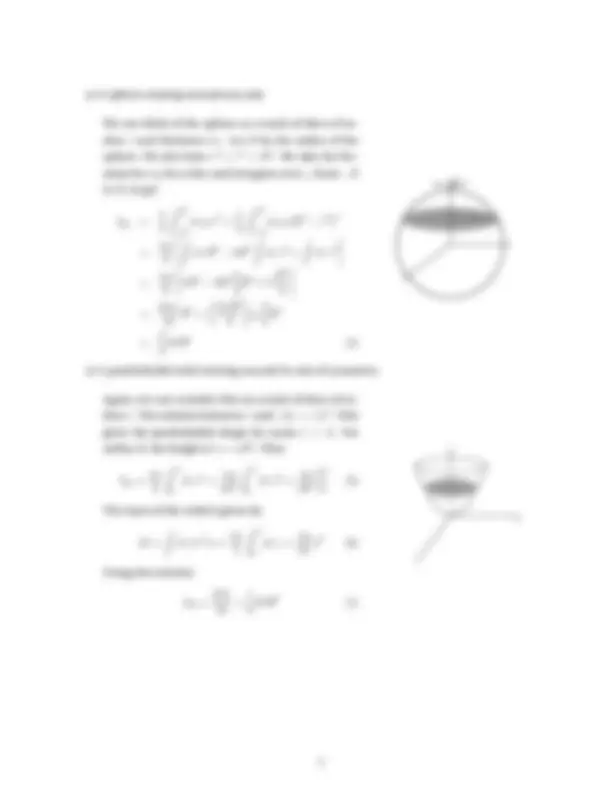



Study with the several resources on Docsity

Earn points by helping other students or get them with a premium plan


Prepare for your exams
Study with the several resources on Docsity

Earn points to download
Earn points by helping other students or get them with a premium plan
Community
Ask the community for help and clear up your study doubts
Discover the best universities in your country according to Docsity users
Free resources
Download our free guides on studying techniques, anxiety management strategies, and thesis advice from Docsity tutors
Calculations for the moments of inertia of various shapes when rotating around their respective axes. The shapes considered are a rod, a circular disc, a sphere, and a paraboloidal solid. The moments of inertia are determined using the integral of mass times radius squared, with respect to the axis of rotation.
What you will learn
Typology: Study notes
1 / 2

This page cannot be seen from the preview
Don't miss anything!


Some sample calculations of the moment of inertia
a) A rod rotating around an axis perpendicular to it at one end
We consider a rod of length L, and thickness in the two transverse directions as ∆, with ∆ L. We take the axis of rotation to be along the x 3 -direction, so that the rod is in the (x 1 , x 2 )-plane. The angular ve- locity is thus Ω = (0~ , 0 , Ω). The kinetic energy is evi- dently T = 12 IabΩaΩb = 12 I 33 Ω^2. We can then write
y
x
z
Ω
ρ(ξ~ · ξ~ − ξ 3 ξ 3 ) =
ρ
ξ^21 + ξ 22
dξ 1 dξ 2 dξ 3 ρ ξ^21 +
dξ 1 dξ 2 dξ 3 ρ ξ 22
= ρ
(^2) + ρ 2 3
≈ (ρL∆^2 ) L
2 3
2 3
The range of integration is from zero to L for ξ 1 and −∆/ 2 to ∆/ 2 for ξ 2 and ξ 3. In the last line we have used the fact that ∆ L to discard the term proportional to ∆^4. Also M = ρL∆^2 is the mass of the rod. Thus the relevant moment of inertia is
I 33 = M L
2 3
a) A circular disc rotating around its axis
In this case, we can again take the axis of the disc to be along the x 3 -axis, with Ω = (0~ , 0 , Ω). Once again the only relevant component for the moment of in- ertia is I 33. Let ∆ denote the thickness of the disc and let R be its radius. In this case, it is simplest to use cylindrical coordinates because of the obvious symmetry. Thus
x
y
z
R
d^3 ξ ρ (ξ 12 + ξ^22 ) =
0
r^2 dr dϕdz ρ
= ρ R
4 4 2 π ∆ = ρ (πR^2 ∆) R
2 2 = 12 M R^2 (3)
Notice that, in this case, we are not taking ∆ to be very small, so the result also applies to a cylinder of height ∆ rotating around its own axis.
1
a) A sphere rotating around any axis
We can think of the sphere as a stack of discs of ra- dius r and thickness dz. Let R be the radius of the sphere. We also have z^2 + r^2 = R^2. We take the for- mula for I 33 for a disc and integrate over z, from −R to R, to get
I 33 = π 2
−R
dz ρ r^4 = π 2
−R
dz ρ (R^2 − z^2 )^2
= πρ 2
dz R^4 − 2 R^2
dz z^2 +
dz z^4
= πρ 2
5 5
= 8 πρ 15
4 πR^3 3
ρ 2 5
Ω
r
a) A paraboloidal solid rotating around its axis of symmetry
Again, we can consider this as a stack of discs of ra- dius r. The relation between r and z is z = λr^2. This gives the paraboloidal shape for some λ > 0. For radius R, the height is h = λR^2. Thus
I 33 = πρ 2
∫ (^) h
0
dz r^4 = πρ 2 λ^2
∫ (^) h
0
dz z^2 = πρ 2 λ^2
h^3 3
The mass of the solid is given by
M =
dz πr^2 ρ = πρλ
∫ (^) h
0
dz z = πρ 2 λ h^2 (6)
Using this relation
I 33 = M h 2 λ =
x
z
y